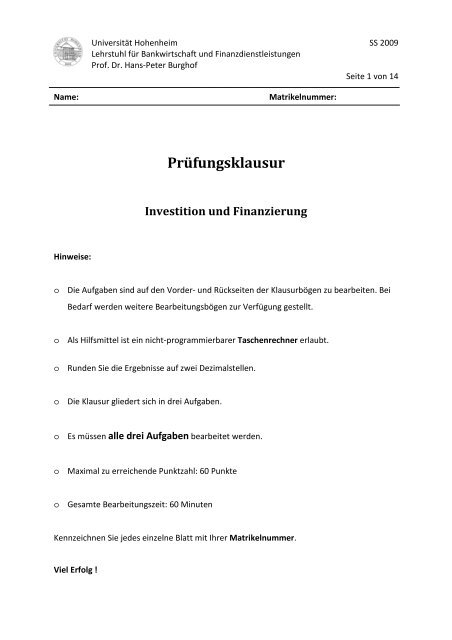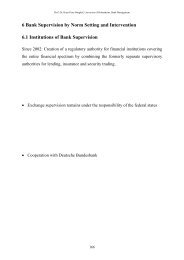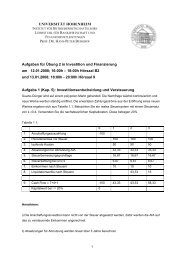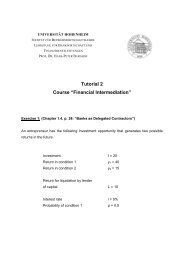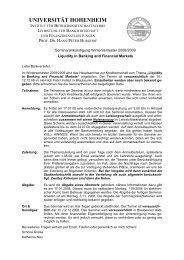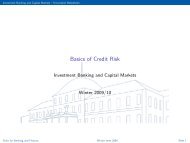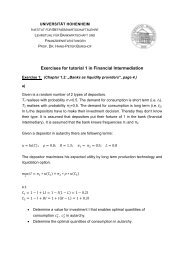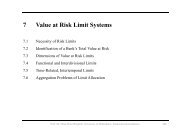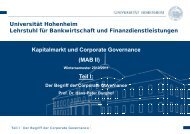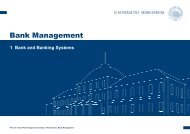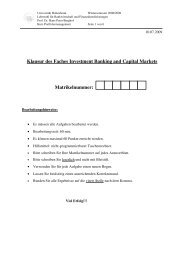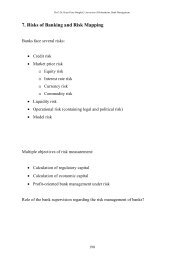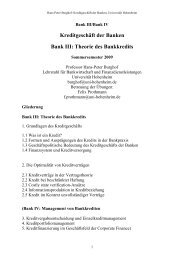Klausur Aufgaben IuF SS09_V1.1 - Lehrstuhl für Bankwirtschaft ...
Klausur Aufgaben IuF SS09_V1.1 - Lehrstuhl für Bankwirtschaft ...
Klausur Aufgaben IuF SS09_V1.1 - Lehrstuhl für Bankwirtschaft ...
Sie wollen auch ein ePaper? Erhöhen Sie die Reichweite Ihrer Titel.
YUMPU macht aus Druck-PDFs automatisch weboptimierte ePaper, die Google liebt.
Universität Hohenheim SS 2009<br />
<strong>Lehrstuhl</strong> <strong>für</strong> <strong>Bankwirtschaft</strong> und Finanzdienstleistungen<br />
Prof. Dr. Hans-Peter Burghof<br />
Seite 1 von 14<br />
Name: Matrikelnummer:<br />
Hinweise:<br />
Prüfungsklausur<br />
Investition und Finanzierung<br />
o Die <strong>Aufgaben</strong> sind auf den Vorder- und Rückseiten der <strong>Klausur</strong>bögen zu bearbeiten. Bei<br />
Bedarf werden weitere Bearbeitungsbögen zur Verfügung gestellt.<br />
o Als Hilfsmittel ist ein nicht-programmierbarer Taschenrechner erlaubt.<br />
o Runden Sie die Ergebnisse auf zwei Dezimalstellen.<br />
o Die <strong>Klausur</strong> gliedert sich in drei <strong>Aufgaben</strong>.<br />
o Es müssen alle drei <strong>Aufgaben</strong> bearbeitet werden.<br />
o Maximal zu erreichende Punktzahl: 60 Punkte<br />
o Gesamte Bearbeitungszeit: 60 Minuten<br />
Kennzeichnen Sie jedes einzelne Blatt mit Ihrer Matrikelnummer.<br />
Viel Erfolg !
Universität Hohenheim SS 2009<br />
<strong>Lehrstuhl</strong> <strong>für</strong> <strong>Bankwirtschaft</strong> und Finanzdienstleistungen<br />
Prof. Dr. Hans-Peter Burghof<br />
Seite 2 von 14<br />
Aufgabe A (20P)<br />
[A1] (12P)<br />
Beantworten Sie folgende Fragen. Beschränken Sie sich dabei auf maximal zwei bis drei Sät-<br />
ze.<br />
i) Was versteht man unter dem Verschuldungsgrad eines Unternehmens?<br />
ii) Was ist der Kapitalwert?<br />
iii) Welche zwei Ziele verfolgt man bei einer Finanzplanung?
Universität Hohenheim SS 2009<br />
<strong>Lehrstuhl</strong> <strong>für</strong> <strong>Bankwirtschaft</strong> und Finanzdienstleistungen<br />
Prof. Dr. Hans-Peter Burghof<br />
Seite 3 von 14<br />
iv) Was versteht man unter einer Opération blanche?<br />
v) Was versteht man unter einer Innenfinanzierung?<br />
vi) Was besagt die Annuität?
Universität Hohenheim SS 2009<br />
<strong>Lehrstuhl</strong> <strong>für</strong> <strong>Bankwirtschaft</strong> und Finanzdienstleistungen<br />
Prof. Dr. Hans-Peter Burghof<br />
Seite 4 von 14<br />
[A2] (8P)<br />
Was versteht man unter dem internen Zinsfuß einer Investition? Definieren Sie diesen zu-<br />
nächst. Beschreiben Sie darüberhinaus mit Hilfe einer Grafik, in der der Kapitalwert einer<br />
Investition in Abhängigkeit des Zinssatzes gestellt wird, was unter einem internen Zinsfuß<br />
verstanden wird. Nach welchem Kriterium wird beim internen Zinsfuß entschieden, ob ein<br />
Projekt durchgeführt wird?
Universität Hohenheim SS 2009<br />
<strong>Lehrstuhl</strong> <strong>für</strong> <strong>Bankwirtschaft</strong> und Finanzdienstleistungen<br />
Prof. Dr. Hans-Peter Burghof<br />
Seite 5 von 14<br />
Aufgabe B (Kapitalwert; 20P)<br />
Ein Unternehmer hat die Wahl zwischen zwei sich gegenseitig ausschließenden Investitions-<br />
alternativen. Die Zahlungsströme der beiden Investitionsmöglichkeiten finden Sie in der fol-<br />
genden Tabelle.<br />
t = 0 t = 1 t = 2 … t = ∞<br />
Projekt 1 Nettozahlungsstrom -1000 0 1300<br />
Projekt 2 Nettozahlungsstrom -1000 55 55(1+g) … 55(1+g) ∞<br />
Projekt 2 besteht aus einer Anschaffungsauszahlung und einer wachsenden ewigen Rente<br />
beginnend ab 1, die erstmals in 2 wächst. Die Wachstumsrate beträgt 0,05.<br />
[B1] (7P)<br />
Bestimmen Sie die Kapitalwerte der beiden Projekte unter Verwendung eines Kapitalkosten-<br />
satzes von 0,10. Für welches Projekt entscheidet sich der Unternehmer auf Basis der<br />
Ergebnisse?
Universität Hohenheim SS 2009<br />
<strong>Lehrstuhl</strong> <strong>für</strong> <strong>Bankwirtschaft</strong> und Finanzdienstleistungen<br />
Prof. Dr. Hans-Peter Burghof<br />
Seite 6 von 14
Universität Hohenheim SS 2009<br />
<strong>Lehrstuhl</strong> <strong>für</strong> <strong>Bankwirtschaft</strong> und Finanzdienstleistungen<br />
Prof. Dr. Hans-Peter Burghof<br />
Seite 7 von 14<br />
[B2] (8 Punkte)<br />
Berechnen Sie <strong>für</strong> beide Projekte jeweils den internen Zinsfuß? Für welches Projekt ent-<br />
scheidet sich der Investor auf Basis dieser Ergebnisse?
Universität Hohenheim SS 2009<br />
<strong>Lehrstuhl</strong> <strong>für</strong> <strong>Bankwirtschaft</strong> und Finanzdienstleistungen<br />
Prof. Dr. Hans-Peter Burghof<br />
Seite 8 von 14<br />
[B3] (5P)<br />
Berechnen Sie <strong>für</strong> beide Projekte die Annuitätszahlungen <strong>für</strong> die jeweiligen Laufzeiten. Ver-<br />
wenden Sie <strong>für</strong> die Berechnung nicht die in [B1] erhaltenen Kapitalwerte, sondern gehen Sie<br />
<strong>für</strong> Projekt A von einem Kapitalwert von 80 aus, <strong>für</strong> Projekt B von 100.<br />
Ist ein Vergleich der Annuität <strong>für</strong> beide Projekte sinnvoll?
Universität Hohenheim SS 2009<br />
<strong>Lehrstuhl</strong> <strong>für</strong> <strong>Bankwirtschaft</strong> und Finanzdienstleistungen<br />
Prof. Dr. Hans-Peter Burghof<br />
Seite 9 von 14<br />
Aufgabe C (Kapitalstruktur; 20P)<br />
[C1] (5P)<br />
Unternehmen X wird voraussichtlich im Folgejahr eine Gesamtkapitalrendite von 6% erwirt-<br />
schaften. Es hat einen Verschuldungsgrad von 2. Das Unternehmen X hat sich zum Ziel ge-<br />
setzt, eine Eigenkapitalrendite von 10% zu erreichen. Zu welchem Zins muss es sich dann das<br />
erforderliche Fremdkapital beschaffen, um diese Eigenkapitalrendite zu erzielen?
Universität Hohenheim SS 2009<br />
<strong>Lehrstuhl</strong> <strong>für</strong> <strong>Bankwirtschaft</strong> und Finanzdienstleistungen<br />
Prof. Dr. Hans-Peter Burghof<br />
Seite 10 von 14<br />
[C2] (5P)<br />
Ein anderes Unternehmen ist sich über die im kommenden Jahr zu erreichende Gesamtkapi-<br />
talrendite unsicher. Je nach Szenario kann diese unterschiedlich hoch sein. Jedes Szena-<br />
rio tritt mit einer Wahrscheinlichkeit von ein.<br />
Szenario 1 2 3<br />
0,03 0,06 0,10<br />
0,20 0,30 0,50<br />
Das Unternehmen kann sich Fremdkapital zum Zins von 0,08 beschaffen, der in allen Szena-<br />
rien konstant ist.<br />
Wie hoch ist der größtmögliche Verschuldungsgrad, mit dem die Unternehmung in keinem<br />
der Szenarien eine negative Eigenkapitalrendite erzielen wird?<br />
Wie hoch darf das Fremdkapital maximal sein, wenn das Unternehmen Eigenkapital in Höhe<br />
von 3 Mio € hat?
Universität Hohenheim SS 2009<br />
<strong>Lehrstuhl</strong> <strong>für</strong> <strong>Bankwirtschaft</strong> und Finanzdienstleistungen<br />
Prof. Dr. Hans-Peter Burghof<br />
Seite 11 von 14
Universität Hohenheim SS 2009<br />
<strong>Lehrstuhl</strong> <strong>für</strong> <strong>Bankwirtschaft</strong> und Finanzdienstleistungen<br />
Prof. Dr. Hans-Peter Burghof<br />
Seite 12 von 14<br />
[C3] (5P)<br />
Es gelten die Voraussetzungen von <strong>Aufgaben</strong>teil [C2]. Allerdings habe das Unternehmen nun<br />
eine Fremdkapitalquote (Fremdkapital / Gesamtkapital) von 30%. Wie hoch ist dann die er-<br />
wartete Eigenkapitalrendite ?
Universität Hohenheim SS 2009<br />
<strong>Lehrstuhl</strong> <strong>für</strong> <strong>Bankwirtschaft</strong> und Finanzdienstleistungen<br />
Prof. Dr. Hans-Peter Burghof<br />
Seite 13 von 14<br />
[C4] (5P)<br />
Wie in <strong>Aufgaben</strong>teil [C2] und [C3] sei die Gesamtkapitalrendite unsicher und kann je nach<br />
Szenario folgende Werte annehmen:<br />
Szenario 1 2 3<br />
rGK 0,03 0,06 0,10<br />
Der Fremdkapitalzins liegt weiter bei 0,08. Der Verschuldungsgrad kann zwischen 0 und 3<br />
variieren.<br />
Zeigen Sie in einer Grafik das Verhältnis von Verschuldungsgrad und Eigenkapitalrendite <strong>für</strong><br />
die verschiedenen Szenarien.<br />
Führt ein höherer Verschuldungsgrad grundsätzlich zu einer höheren Eigenkapitalrendite?<br />
Begründen Sie Ihre Antwort.
Universität Hohenheim SS 2009<br />
<strong>Lehrstuhl</strong> <strong>für</strong> <strong>Bankwirtschaft</strong> und Finanzdienstleistungen<br />
Prof. Dr. Hans-Peter Burghof<br />
Seite 14 von 14
Universität Hohenheim SS 2009<br />
<strong>Lehrstuhl</strong> <strong>für</strong> <strong>Bankwirtschaft</strong> und Finanzdienstleistungen<br />
Prof. Dr. Hans‐Peter Burghof<br />
Seite 1 von 5<br />
Name: Matrikelnummer:<br />
Please note:<br />
ENGLISCH<br />
Prüfungsklausur<br />
Investment and Financing<br />
o Answer the question using the front and back side of the question sheets. If the space is<br />
not sufficient, spare paper will be provided.<br />
o No other tools than a non‐programmable pocket calculator are allowed.<br />
o The exam consists of three questions.<br />
o All three questions must be answered.<br />
o Highest obtainable score: 60 points<br />
o Total time of exam: 60 minutes<br />
Good luck!
Universität Hohenheim SS 2009<br />
<strong>Lehrstuhl</strong> <strong>für</strong> <strong>Bankwirtschaft</strong> und Finanzdienstleistungen<br />
Prof. Dr. Hans‐Peter Burghof<br />
Seite 2 von 5<br />
Exercise A (20P)<br />
[A1] (12P)<br />
Please answer the following questions. Limit your answer to two or three sentences.<br />
i) What is the debt‐to‐equity rule?<br />
ii) What is the net present value?<br />
iii) Which are the two main objectives of financial planning?<br />
iv) What is an Opération blanche?<br />
v) What can be understood by an internal financing?<br />
vi) What is meant by the annuity?<br />
[A2] (8P)<br />
What is the internal rate of return? Define it. Furthermore, describe the internal rate of re‐<br />
turn with the help of a graph, in which the relation between the net present value and the<br />
interest rate is illustrated. According to which criteria based on the internal rate of return, it<br />
is decided whether a project is financed?
Universität Hohenheim SS 2009<br />
<strong>Lehrstuhl</strong> <strong>für</strong> <strong>Bankwirtschaft</strong> und Finanzdienstleistungen<br />
Prof. Dr. Hans‐Peter Burghof<br />
Seite 3 von 5<br />
Excercise B (Net Present Value; 20P)<br />
An entrepreneur has the choice between two different investment alternatives, which are<br />
mutually exclusive. The cash flows of both investment opportunities are shown in the table<br />
below:<br />
t = 0 t = 1 t = 2 … t = ∞<br />
Project 1 Net cash flow ‐1000 0 1300<br />
Project 2 Net cash flow ‐1000 55 55(1+g) … 55(1+g) ∞<br />
Project 2 consists of an investment amount in , and a growing perpetuity from<br />
on, which grows for the first time in . The growth rate is 0,05.<br />
[B1] (7P)<br />
Calculate the net present value of both projects for an interest rate of . For which<br />
project the entrepreneur decides for based on the obtained results?<br />
[B2] (8 Punkte)<br />
Calculate the internal rate of return for both projects. For which project the entrepreneur<br />
decides for based on the obtained results?<br />
[B3] (5P)<br />
Calculate the annuity for both projects. Do not consider the net present values calculated in<br />
[B1], but assume for project A a net present value of 80, for project B a net present value of<br />
100.<br />
Is it reasonable to compare the annuity for both projects?
Universität Hohenheim SS 2009<br />
<strong>Lehrstuhl</strong> <strong>für</strong> <strong>Bankwirtschaft</strong> und Finanzdienstleistungen<br />
Prof. Dr. Hans‐Peter Burghof<br />
Seite 4 von 5<br />
Excercise C (Capital Structure; 20P)<br />
[C1] (5P)<br />
Firm X generates a return of assets of 6% ( in the next financial year. It has a level of<br />
debt of 2. Firm X has the goal to obtain a return on equity of 10%. How high should be the<br />
cost of debt to reach this goal?<br />
[C2] (5P)<br />
Another firm is uncertain about the return on assets ( that can be generated in the<br />
next financial year. Depending on the respective scenario, it can be different. Each scenario<br />
has a probability of .<br />
Scenario 1 2 3<br />
0,03 0,06 0,10<br />
0,20 0,30 0,50<br />
For the firm, cost of debt are at 8%, which is constant across all scenarios.<br />
How large can be the level of debt so that the firm does not generate a negative return on<br />
equity in each scenario?<br />
How large can be the amount of debt to prevent the firm from a negative return on equity if<br />
the firm has equity as high as 3 Mio €?<br />
[C3] (5P)<br />
The assumptions of Exercise [C2] are still present. However, now, the firm has a debt ratio<br />
(debt/total capital) of 30%. How large is the expected return on equity ?
Universität Hohenheim SS 2009<br />
<strong>Lehrstuhl</strong> <strong>für</strong> <strong>Bankwirtschaft</strong> und Finanzdienstleistungen<br />
Prof. Dr. Hans‐Peter Burghof<br />
Seite 5 von 5<br />
[C4] (5P)<br />
As in Exercise [C2] and [C3], the total return on assets is uncertain. It depends on the respec‐<br />
tive scenario and can take the following values:<br />
Scenario 1 2 3<br />
rGK 0,03 0,06 0,10<br />
The cost of debt are at 8%. The level of debt varies between 0 and 3.<br />
Show graphically the relationship between the level of debt and the return on equity for the<br />
different scenarios. Show also mathematically how the graphs are calculated for the scena‐<br />
rios.<br />
Does a higher level of debt imply a higher return of equity? Explain your answer.
Universität Hohenheim WS 2008 / 2009<br />
<strong>Lehrstuhl</strong> <strong>für</strong> <strong>Bankwirtschaft</strong> und Finanzdienstleistungen<br />
Prof. Dr. Hans-Peter Burghof<br />
Seite 1 von 18<br />
Name: Matrikelnummer:<br />
WS 2008/09<br />
Prüfungsklausur<br />
Investition und Finanzierung
Hinweise:<br />
Universität Hohenheim WS 2008 / 2009<br />
<strong>Lehrstuhl</strong> <strong>für</strong> <strong>Bankwirtschaft</strong> und Finanzdienstleistungen<br />
Prof. Dr. Hans-Peter Burghof<br />
Seite 2 von 18<br />
Prüfungsklausur<br />
Investition und Finanzierung<br />
o Die <strong>Aufgaben</strong> sind auf den Vorder- und Rückseiten der <strong>Klausur</strong>bögen zu bearbeiten. Bei<br />
Bedarf werden weitere Bearbeitungsbögen zur Verfügung gestellt.<br />
o Als Hilfsmittel ist ein nicht-programmierbarer Taschenrechner erlaubt.<br />
o Die <strong>Klausur</strong> gliedert sich in drei <strong>Aufgaben</strong>.<br />
o Es müssen alle drei <strong>Aufgaben</strong> bearbeitet werden<br />
o Maximal zu erreichende Punktzahl: 60 Punkte<br />
o Gesamte Bearbeitungszeit: 60 Minuten<br />
Kennzeichnen Sie jedes einzelne Blatt mit Ihrer Matrikelnummer.<br />
Viel Erfolg !
Universität Hohenheim WS 2008 / 2009<br />
<strong>Lehrstuhl</strong> <strong>für</strong> <strong>Bankwirtschaft</strong> und Finanzdienstleistungen<br />
Prof. Dr. Hans-Peter Burghof<br />
Seite 3 von 18<br />
Aufgabe A (Entscheidungstheorie; 20P)<br />
[A1] (6P)<br />
In einer Nutzenfunktion wird die Einstellung eines Entscheiders zum Risiko ausgedrückt.<br />
Welche drei Risikoeinstellungen werden im Allgemeinen unterschieden.<br />
• Nenne Sie diese.<br />
• Zeichnen Sie jeweils in einer Grafik einen möglichen Verlauf der Nutzenfunktion bei<br />
der jeweiligen Risikoeinstellung.<br />
• Drücken Sie jeweils in einer Gleichung das Verhältnis vom Nutzen des Erwartungs-<br />
werts (U(E)) zum Erwartungsnutzen E(U) aus.
Universität Hohenheim WS 2008 / 2009<br />
<strong>Lehrstuhl</strong> <strong>für</strong> <strong>Bankwirtschaft</strong> und Finanzdienstleistungen<br />
Prof. Dr. Hans-Peter Burghof<br />
Seite 4 von 18<br />
[A2] (2P)<br />
Definieren Sie Sicherheitsäquivalent und Risikoprämie.
Universität Hohenheim WS 2008 / 2009<br />
<strong>Lehrstuhl</strong> <strong>für</strong> <strong>Bankwirtschaft</strong> und Finanzdienstleistungen<br />
Prof. Dr. Hans-Peter Burghof<br />
Seite 5 von 18<br />
[A3] (6P)<br />
Ein Unternehmer hat die Wahl zwischen drei Investitionsprojekten. Er kann höchstens eines<br />
durchführen. Für jedes ist eine Investition von 1000€ erforderlich. Der Rückfluss aus den<br />
Projekten ist unsicher und abhängig vom Zustand der Gesamtwirtschaft. Die Wahrschein-<br />
lichkeit der drei Zustände sowie die jeweiligen Rückflüsse sind in der unteren Tabelle ange-<br />
geben:<br />
Umweltzustand <br />
Projekt A Projekt B Projekt C<br />
<br />
1 0,3 850 0,3 1200 0,3 1020<br />
2 0,2 3400 0,2 600 0,2 700<br />
3 0,5 600 0,5 1100 0,5 910<br />
Des Weiteren hat der Investor folgende Nutzenfunktion.<br />
√ <strong>für</strong> 1000<br />
√ 20 <strong>für</strong> 1000<br />
Ermitteln Sie zunächst, ob ein Projekt ausgeschlossen werden kann, wenn nach dem Kapi-<br />
talwert-Kriterium entschieden wird (Gehen Sie vereinfachend von einem Zinssatz von 0%<br />
aus).<br />
Berechnen Sie, welches der (verbliebenen) Projekte gewählt wird, wenn davon ausgegangen<br />
wird, dass der Investor seinen erwarteten Nutzen aus den Rückflüssen maximieren möchte.
Universität Hohenheim WS 2008 / 2009<br />
<strong>Lehrstuhl</strong> <strong>für</strong> <strong>Bankwirtschaft</strong> und Finanzdienstleistungen<br />
Prof. Dr. Hans-Peter Burghof<br />
Seite 6 von 18
Universität Hohenheim WS 2008 / 2009<br />
<strong>Lehrstuhl</strong> <strong>für</strong> <strong>Bankwirtschaft</strong> und Finanzdienstleistungen<br />
Prof. Dr. Hans-Peter Burghof<br />
Seite 7 von 18<br />
[A4] (6P)<br />
Student B nimmt an einer Lotterie teil. Er hat eine Nutzenfunktion von √, wobei <br />
der mögliche Gewinn sei. Ein Los kostet 9€. Student B gewinnt mit einer Wahrscheinlichkeit<br />
von 95% einen Betrag von 2€. Wie hoch muss der Gewinn mindestens sein, den er mit einer<br />
Wahrscheinlichkeit von 5% erhält, damit er bereit ist, an der Lotterie teilzunehmen?
Universität Hohenheim WS 2008 / 2009<br />
<strong>Lehrstuhl</strong> <strong>für</strong> <strong>Bankwirtschaft</strong> und Finanzdienstleistungen<br />
Prof. Dr. Hans-Peter Burghof<br />
Seite 8 von 18
Universität Hohenheim WS 2008 / 2009<br />
<strong>Lehrstuhl</strong> <strong>für</strong> <strong>Bankwirtschaft</strong> und Finanzdienstleistungen<br />
Prof. Dr. Hans-Peter Burghof<br />
Seite 9 von 18<br />
Aufgabe B (Kapitalwert; 20P)<br />
Unternehmen A möchte im Ausland eine Produktionsanlage errichten. Diese kostet in 0<br />
einen Betrag von 10.000.000€. Nach vier Jahren möchte sich das Unternehmen von diesem<br />
Markt wieder zurückziehen. In der Produktionsanlage können monatlich 10.000 Schuhpaare<br />
produziert werden, die einen Marktpreis von 80€ haben. Die Anlage produziert 12 Monate<br />
im Jahr. Der Betrieb der Anlage verursacht Fixkosten in Höhe von 600.000€ pro Jahr und va-<br />
riable Kosten in Höhe von 40€ pro Schuhpaar. Nehmen Sie einen Zinssatz von 8% an.<br />
[B1] (5P)<br />
Lohnt sich die Produktionsanlage? Berechnen Sie hierzu den Kapitalwert. Legen Sie hier<strong>für</strong><br />
die Zahlungen am Jahresende zugrunde.
Universität Hohenheim WS 2008 / 2009<br />
<strong>Lehrstuhl</strong> <strong>für</strong> <strong>Bankwirtschaft</strong> und Finanzdienstleistungen<br />
Prof. Dr. Hans-Peter Burghof<br />
Seite 10 von 18
Universität Hohenheim WS 2008 / 2009<br />
<strong>Lehrstuhl</strong> <strong>für</strong> <strong>Bankwirtschaft</strong> und Finanzdienstleistungen<br />
Prof. Dr. Hans-Peter Burghof<br />
Seite 11 von 18<br />
[B2] (8P)<br />
Wie viele Schuhpaare muss die Produktionsanlage pro Monat mindestens fertigen, damit<br />
das Projekt nach dem Kapitalwert-Kriterium noch profitabel ist?
Universität Hohenheim WS 2008 / 2009<br />
<strong>Lehrstuhl</strong> <strong>für</strong> <strong>Bankwirtschaft</strong> und Finanzdienstleistungen<br />
Prof. Dr. Hans-Peter Burghof<br />
Seite 12 von 18
Universität Hohenheim WS 2008 / 2009<br />
<strong>Lehrstuhl</strong> <strong>für</strong> <strong>Bankwirtschaft</strong> und Finanzdienstleistungen<br />
Prof. Dr. Hans-Peter Burghof<br />
Seite 13 von 18<br />
[B3] (7P)<br />
Wie verändert sich der Kapitalwert, wenn die Schuhpaare anstatt <strong>für</strong> 80 € nur <strong>für</strong> 75 € ver-<br />
kauft werden können. Gehen Sie wieder, wie zu Beginn, von einer monatlichen Produktion<br />
von 10.000 Schuhpaaren aus. Unterstellen Sie nun jedoch, dass die Produktionsanlage 20<br />
Jahre betrieben wird.
Universität Hohenheim WS 2008 / 2009<br />
<strong>Lehrstuhl</strong> <strong>für</strong> <strong>Bankwirtschaft</strong> und Finanzdienstleistungen<br />
Prof. Dr. Hans-Peter Burghof<br />
Seite 14 von 18
Universität Hohenheim WS 2008 / 2009<br />
<strong>Lehrstuhl</strong> <strong>für</strong> <strong>Bankwirtschaft</strong> und Finanzdienstleistungen<br />
Prof. Dr. Hans-Peter Burghof<br />
Seite 15 von 18<br />
Aufgabe C (Fremdfinanzierung; Kapitalstruktur; 20P)<br />
[C1] (4P)<br />
Nennen Sie zwei Formen der langfristigen Fremdfinanzierung und zwei der kurzfristigen<br />
Fremdfinanzierung. (Eine Beschreibung der einzelnen Formen ist nicht verlangt.)
Universität Hohenheim WS 2008 / 2009<br />
<strong>Lehrstuhl</strong> <strong>für</strong> <strong>Bankwirtschaft</strong> und Finanzdienstleistungen<br />
Prof. Dr. Hans-Peter Burghof<br />
Seite 16 von 18<br />
[C2] (6P)<br />
Die durchschnittlichen Kapitalkosten betragen , die Fremdkapitalkosten werden mit <br />
bezeichnet. Eigenkapital sei mit EK, Fremdkapital mit FK abgekürzt.<br />
Es sei:<br />
<br />
<br />
<br />
<br />
<br />
Leiten Sie aus obiger Formel die folgende Formel <strong>für</strong> die erwartete Eigenkapitalrendite her:<br />
Erwartete EK‐Rendite <br />
.
Universität Hohenheim WS 2008 / 2009<br />
<strong>Lehrstuhl</strong> <strong>für</strong> <strong>Bankwirtschaft</strong> und Finanzdienstleistungen<br />
Prof. Dr. Hans-Peter Burghof<br />
Seite 17 von 18<br />
[C3] (6P)<br />
Ein Unternehmen möchte eine Eigenkapitalrendite von 20% erzielen. Die Fremdkapitalzinsen<br />
liegen bei 10%, die Gesamtkapitalrendite beträgt 12%.<br />
Wie hoch muss der Verschuldungsgrad sein, damit das Unternehmen das Ziel erreicht?
Universität Hohenheim WS 2008 / 2009<br />
<strong>Lehrstuhl</strong> <strong>für</strong> <strong>Bankwirtschaft</strong> und Finanzdienstleistungen<br />
Prof. Dr. Hans-Peter Burghof<br />
Seite 18 von 18<br />
[C4] (4P)<br />
Ein Unternehmen habe Fremdkapital in Höhe von 3 Mio.€ und Eigenkapital in Höhe von<br />
1 Mio.€. Die Eigenkapitalrendite liege bei 12% und die Fremdkapitalzinsen bei 9%.<br />
Ermitteln Sie die durchschnittliche Gesamtkapitalrendite.
Universität Hohenheim WS 2008 / 2009<br />
<strong>Lehrstuhl</strong> <strong>für</strong> <strong>Bankwirtschaft</strong> und Finanzdienstleistungen<br />
Prof. Dr. Hans-Peter Burghof<br />
Seite 1 von 5<br />
Name: Matrikelnummer:<br />
Please note:<br />
ENGLISCH<br />
Prüfungsklausur<br />
Investment and Financing<br />
o Answer the question using the front and back side of the question sheets. If the space is<br />
not sufficient, spare paper will be provided.<br />
o No other tools than a non-programmable pocket calculator are allowed.<br />
o The exam consists of three questions.<br />
o All three questions must be answered.<br />
o Highest obtainable score: 60 points<br />
o Total time of exam: 60 minutes<br />
Good luck!
Universität Hohenheim WS 2008 / 2009<br />
<strong>Lehrstuhl</strong> <strong>für</strong> <strong>Bankwirtschaft</strong> und Finanzdienstleistungen<br />
Prof. Dr. Hans-Peter Burghof<br />
Seite 2 von 5<br />
Exercise A (Decision Theory; 20P)<br />
[A1] (6P)<br />
A utility function expresses the investor’s attitude towards risk. The literature differentiates<br />
between three types of risk-attitude.<br />
• Please name the three types.<br />
• Illustrate for each risk-attitude a potential pattern of the utility function in a graphic.<br />
• Show for each risk-attitude mathematically the relationship between the utility of the<br />
expected value (U(E)) and the expected value of utility E(U).<br />
[A2] (2P)<br />
Please define certainty equivalent and risk premium.<br />
[A3] (6P)<br />
A firm has the choice between four investment projects. However, only one project can be<br />
carried out. For each project, an investment of 1000€ is necessary. The return is uncertain<br />
and depends on the state of the economy. The probabilities of the three states as well as the<br />
respective returns are reported in the table below.<br />
State <br />
Project A Project B Project C<br />
<br />
1 0,3 850 0,3 1200 0,3 1020<br />
2 0,2 3400 0,2 600 0,2 700<br />
3 0,5 600 0,5 1100 0,5 910<br />
The investor has the following utility function:<br />
√ for 1000<br />
√ 20 for 1000
Universität Hohenheim WS 2008 / 2009<br />
<strong>Lehrstuhl</strong> <strong>für</strong> <strong>Bankwirtschaft</strong> und Finanzdienstleistungen<br />
Prof. Dr. Hans-Peter Burghof<br />
Seite 3 von 5<br />
Examine first, whether one of the three projects can be excluded according to the net<br />
present value criterion (For simplicity assume an interest rate of 0%).<br />
Examine which of the (remaining) projects is chosen given that the investor intends to max-<br />
imize her expected utility from the returns.<br />
[A4] (6P)<br />
Student B participates in a lottery. Her utility function is determined by √, where <br />
is the potential payoff. One lottery ticket costs 9 €. With a probability of 95%, student B ob-<br />
tains a payoff of 2 €. How large must be the payoff which is realized with a probability of 5%<br />
at least that the student is prepared to participate in the lottery?
Universität Hohenheim WS 2008 / 2009<br />
<strong>Lehrstuhl</strong> <strong>für</strong> <strong>Bankwirtschaft</strong> und Finanzdienstleistungen<br />
Prof. Dr. Hans-Peter Burghof<br />
Seite 4 von 5<br />
Exercise B (Net Present Value; 20P)<br />
Firm A plans to build a production facility abroad. In 0, it costs 10,000,000€. After four<br />
years, firm A plans to stop production and shut down the facility. Each month, 10.000 pairs<br />
of shoes can be produced in the facility. Each pair of shoes has a market price of 80€. Shoes<br />
are produced in 12 months per year. The production facility causes fixed costs of 600.000€<br />
per year and variable costs of 40€ per pair of shoes. Assume an interest rate of 8%.<br />
[B1] (5P)<br />
Is the production facility profitable? Calculate the net present value of the investment. Use<br />
therefore the returns at the end of a year.<br />
[B2] (8P)<br />
How many pairs of shoes must at least be produced per month in order to ensure that the<br />
project remains profitable according to the net present value criterion?<br />
[B3] (7P)<br />
How does the net present value change if the pairs of shoes can only be sold for 75€ instead<br />
of 80€?<br />
Again assume a monthly production of 10.000 pairs of shoes, but assume now that the pro-<br />
duction facility has an expected lifetime of 20 years.
Universität Hohenheim WS 2008 / 2009<br />
<strong>Lehrstuhl</strong> <strong>für</strong> <strong>Bankwirtschaft</strong> und Finanzdienstleistungen<br />
Prof. Dr. Hans-Peter Burghof<br />
Seite 5 von 5<br />
Exercise C (Debt Financing; Capital Structure; 20P)<br />
[C1] (4P)<br />
Name two examples for long-term debt financing and two examples for short-term debt<br />
financing. (Please note that a description is not necessary).<br />
[C2] (6P)<br />
The average costs of capital are denominated with , the debt costs of capital with . Let<br />
equity be EK and debt capital FK.<br />
Given that:<br />
<br />
<br />
<br />
<br />
<br />
Please derive from the equation above the following equation for the expected rate of re-<br />
turn of equity.<br />
[C3] (6P)<br />
Expected rate of return of equity <br />
.<br />
A firm aims a rate of return of equity of 20%. The costs of debt are at 10%, the average re-<br />
turn at 12%.<br />
How large must be the debt ratio so that the firm reaches its goal?<br />
[C4] (4P)<br />
A firm has debt of 3 Mio. € and equity of 1 Mio. €. The rate of return for equity is at 12% and<br />
the costs for debt at 9%.<br />
Determine the average cost of capital.


